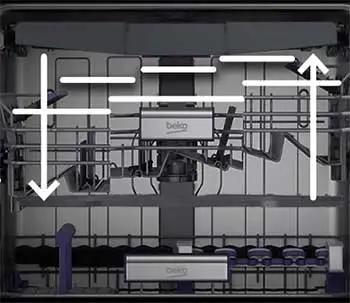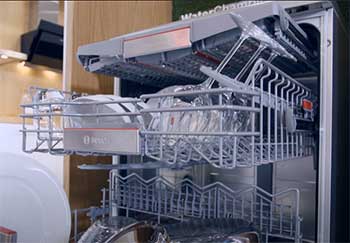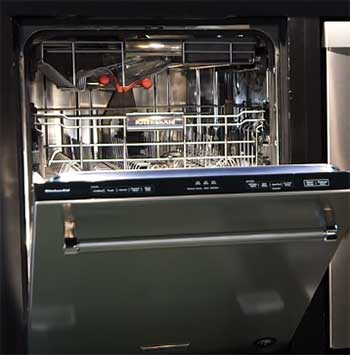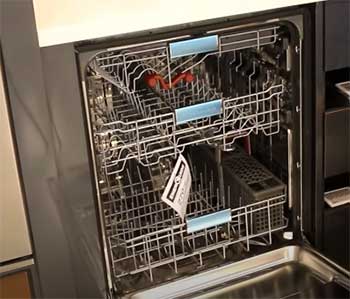When shopping for a dishwasher, most buyers gravitate towards the well-known 24-inch models that can be conveniently installed into standard kitchen spaces.
But for homeowners and renters with compact kitchens, smaller 18-inch “slimline” dishwashers are an attractive option for fitting into tight spots while still giving full-sized cleaning performance.
However, the eye-catching benefit of space-saving design comes at a notable cost. Why exactly are these downsized dishwashers marked higher at retail and online stores? As you compare options, it’s essential to understand where the increased expenses stem from.
Reasons For 18-Inch Dishwashers Being More Expensive
Here is a list of those reasons:
- Specialized Design Engineering
- Niche Market Product Category
- Concentrated Cleaning Power
- Advanced Technological Components
- Custom Cabinet Cutouts & Installation
- Low Inventory & Special Ordering
- Limited Competitive Forces
- Energy Efficiency & Conservation Capabilities
Let’s elaborate those reasons in detail.
Specialized Design Engineering

The root of the price premium traces back to research and development.
Engineering a high-performing dishwasher into a slimmer width is an intensive design project full of complex spatial challenges.
Product developers need to sketch out completely new orientations for critical components like the motor, heating element, control panels, venting, and circulation system parts.
Many custom brackets, tubes, and fittings are required as well along with specially shaped basin and rack dimensions.
It’s a time-intensive process that appliance manufacturers have only recently perfected over the last decade or two. Unlike full-sized dishwashers based on known design templates, these small-but-mighty machines need extensive trial and erroralong with large investments in long design lifecycles.
And those sunk expenses ultimately make their way into higher retail tags. New integrated technologies like advanced sensors and digital displays only heightendevelopment costs as customer expectations for features grow.
So while shoppers simply see a narrow outside frame hiding sophisticated cleaning engineering within, significant research and testing hours enable that sleek exterior illusion. Much more goes on under the hood!
Niche Market Product Category
Another influential pricing dynamic stems from their niche category position. Eighteen-inch dishwashers make up only a tiny sliver – around 5% or less – of all dishwasher sales.
They remain a specialty product catered towards small urban kitchens, dorms, office breakrooms and other uniquely tight spaces. It’s a narrowly targeted market.
Without the sales volume and predictability of traditional dishwashers, manufacturers cannot streamline efficient, large batch production as easily. Factory capacity gets planned out years in advance, so sudden upticks in niche demand lead to scarcer supply and less mass assembly line discounting.
There are also fewer opportunities for parts sharing across higher-volume appliance categories.
In essence, the low unit density directly feeds into higher unit costs passed onto consumers. Midsize dishwashers inhabit a tricky space – specialized functionality for a limited audience.
But over time, if the trend toward smaller urban living spaces accelerates especially with younger demographics pursuing affordable housing, production volumes could ramp up and trim costs as this versatile appliance category expands.
Concentrated Cleaning Power

Make no mistake – while fitting into compact areas, 18-inch dishwashers offer cleaning versatility on par with standard models.
Stainless steel tubs resist corrosion while allowing water to heat faster for optimal sanitization during key wash and rinse cycles.
High velocity spray jets penetrate caked-on food debris from multiple angles, mimicking the pressure sprayers at sinks.
The concentrated jet patterns lead to 35% higher spray force compared to average full-sized dishwashers.
Precision engineering concentrates rapid water dispersal for cleaning rather than wider spray coverage.
Several heavy-duty dishwasher brands like Bosch even introduce higher end models with intelligent sensors that provide real-time feedback on soil levels. The dishwasher automatically adjusts durations and temperatures accordingly for resource conservation.
Some sensors go a step further to determine what specific items occupy racks, fine tuning motions and zones activated. It’s incredibly detailed detection considering the technology packs into such a small footprint matching countertop visual aesthetics.
While narrowed in size, cleaning systems feel just as robust. Internals like the motor, heating element, and drain pump output equivalent or even higher performance specs. The only functional compromise comes down to capacity and load limits.
But with space at a premium, the 8-12 place setting capacity still feels reasonable, and internal racks accommodate larger dinner plates. Pressurized cleaning strength makes up for the tightened quarters.
So concentrated water jets, sensor-guided automation, durable racks, and speedy cycles balance out less internal width – a carefully coordinated engineering act to preserve power dynamics. Shoppers gain the accuracy and intensity of full models with space conscious flexibility.
Advanced Technological Components

Attractive cleaning functionality gets enabled in part by the advanced electronics integrated throughout.
Unlike traditional dishwashers hosting basic analog controls with limited cycle options, 18-inch units run on digital brains similar to smartphones.
Eplex control boards mounted on the front synchronize all internal activity encompassing fill valves, circulation and drain pumps, rotating spray arms, heating elements, moisture sensors, and user interfaces.
The complex circuitry oversees timed choreography making sure spray pressure, water volumes, and temperatures all align to pre-programmed cycles. Some boards come fitted with exterior indicators detailing flow rates, soil sensors, sanitize modes, and end-of-cycle alerts.
It’s compact yet concentrated precision technology enabling friendly user experiences through sleek and intuitive interfaces.
However, the latest silicon computing power and Smart Home capabilities shine a light on lengthy design processes again. Product managers carefully source durable chipsets that avoid overheating and minimize interference with cleaning systems demanding higher energy loads.
There are also usability concerns around condensed selection menus on pint-sized control panels. It takes extensive consumer testing to strike the right balance between desired features and simplicity.
While we as users see an elegant control interface masking the elaborate electronics enabling all core cleaning functionality, significant upfront investments lie behind that facade. And the costs of frequent technological redesigns ultimately pass onto buyers.
Integrating the “smarts” around intuitive controls, flexible programming, and real-time cycle adjustments contributes to premium pricing especially as innovations march forward.
Custom Cabinet Cutouts & Installation

Moving beyond internal components, another pricing implication surrounds cabinetry construction and professional installation.
The 18-inch sizing means most standard kitchen spaces cannot accommodate the appliance without modifications.
New cabinet cutouts must align precisely to the narrowed chassis width along with some filler panel customization to avoid gaps or alignment issues.
Kitchen remodeling experts may also need to relocate plumbing hookups or run new electrical lines to accommodate the shifted appliance layout.
Some builds require installing fresh flooring or re-tiling sections as older materials contained only standard 24-inch dishwasher footprints.
It usually entails at least some degree of construction revisions before fitting dishwashers into place and verifying ideal spray arm clearance under countertops.
While reasonably handy homeowners can tackle installation alone with proper planning, many buyers lean on professional remodeling help given the unit’s heavy weight and integration complexity.
Custom contracting work drives up project costs quickly, especially in higher cost of living urban areas. When bundled into MSRP, it’s another contributor towards inflated retail pricing. But the reassurance of optimized positioning and cabinetry adjustments helps justify the perfect fit.
For consumers pursuing new home construction or full kitchen remodels rather than one-off upgrades, the installation complexity matters less since complete site layout revisions occur anyway. But otherwise count on higher upfront costs when purchasing this specialty appliance category.
Low Inventory & Special Ordering
Once ready to purchase, expect challenges securing 18-inch dishwasher supply on-demand. The niche units inhabit limited shelf space at big box retailers like Lowes or Best Buy compared to ever-present traditional dishwashers.
Due to lower popularity, stores simply don’t prioritize large in-store inventory to avoid tying up working capital across slower selling lines. There are too many size, color, and feature variations as well within manufacturer model ranges.
That leads many buyers down special order paths which add lag time and logistics surcharges onto fulfillment. Local distributors often need to pull supply from regional warehouses or place requests to brands via drop shipping.
And depending on current production cycles, that could trigger weeks or months of lead time especially on premium brands like Miele or Bosch. Their manufacturing capacity stays tight given the low volume niche.
The takeaway here lies with proper planning and order timing. Budget extra contingencies given sourcing uncertainty, and balance cosmetic preferences like color against availability.
By pragmatically managing expectations around inventory timing from the outset, consumers dodge excessive fees common with rush deliveries. It’s an indirect cost reality when selecting low volume appliances.
Limited Competitive Forces
Contrasted with standard sizing, consumers also lose the benefit of intense price competition across brands which could help offset expensive base costs.
The 18-inch segment stays dominated by just a handful of premium manufacturers focusing decades of R&D into perfecting the form factor – notably Bosch, KitchenAid, Miele, Fisher & Paykel, Bertazzoni, and Smeg.
With no impulse purchase opportunities and the need for expert installation, buyers conduct more due diligence like consumers buying vehicles. That leads them to brands exhibiting proven reputation and durable construction.
There are few shortcuts to market with this product category given engineering intricacies and reliability expectations once in place. Only well capitalized brands making big investments in testing and components can succeed long-term.
The small cohort lacks cutthroat value positioning or promotions which budget brands like Frigidaire, LG, and GE employ across full-sized dishwashers. Consumers forgo rock bottom sticker prices in favor of optimized cleaning functionality from established labels.
And without 15+ brands duking it out across big box store aisles, pricing power firms up.
Of course, over time if the market segment achieves enough scale, competitive dynamics could certainly heat up and improve affordability. But given current steady growth trajectories, buyers need to accept the narrow playing field when budgeting appliance upgrades.
The category stays characterized as a “need-driven” rather than “want-driven” purchase.
Energy Efficiency & Conservation Capabilities

A final point circles back to operating costs beyond just purchase price.
Thanks to intensive engineering packed into compact space, 18-inch dishwashers actually drive strong energy and water conservation results over time which help defray higher sticker shock.
It’s a silver lining amortizing the investment through hundreds of cleansing loads across a decade of ownership.
Many slimline dishwashers meet strict ENERGY STAR® certification thresholds by limiting yearly kilowatt-hour electrical usage and power consumption in standby modes.
Precision high-pressure spray nozzles focus every water droplet directly on dishes rather than inefficiently dispersing wider spray patterns which generate excess runoff draining away nutrients.
Built-in soil and turbidity sensorscoupled with purposeful microprocessor-control further fine tune cycles based on detected grime levels while optimizing water volumes needed for a single successful clean.
So the appliance category essentially produces equivalent cleaning results in tighter spaces while cutting resource waste significantly. And avoiding extra electricity or water expenses over 5-10 years really helps validate spending more initially.
Of course upfront budget matters too, but slimline machines make a strong case around long-term energy savings which more basic dishwashers lack – a nice bonus perk layered onto superb wash performance.
Frequently Asked Questions (FAQ)
For small kitchens and apartments with limited space, an 18-inch dishwasher is likely worth the higher cost. You gain full-size cleaning performance minus a few place settings in a narrower footprint. This flexibility and problem-solving design squarely aligns with the higher price.
While less than a standard 24-inch dishwasher, 18-inch models still hold an impressive amount of dishes. Interior capacity ranges from 8 place settings on the low end to 12 place settings on larger models. This nears the capacity of many low to mid-range full-size dishwashers.
In some cases, yes – 18-inch dishwashers can be more water and energy efficient. Precision engineering allows manufacturer’s to optimize the smaller tub size with high-pressure spray jets using less water. Many models also carry ENERGY STAR ratings for low power usage.
Brands positioned at the higher end of the price spectrum predominantly make 18-inch dishwashers today. Key manufacturers include Bosch, Miele, KitchenAid, Fisher & Paykel, Thermador, and Smeg. With premium brand recognition and reputation for quality, these companies command the smaller niche dishwasher space.
Closing Remarks
Eighteen-inch dishwashers demand higher prices based on the research, customized parts, niche market dynamics, installation needs, brand reputation, and feature sets that go into their design and production.
For the right consumers prioritizing space savings and flexibility, the increased costs bring unmatched versatility and quality. Carefully weigh out long term energy savings and resale potential as well.
With some patience navigating special orders and professional installation, these appliances solve tight space constraints that standard models simply cannot.
